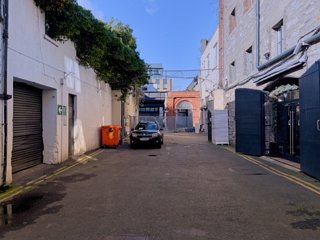ABOUT MEETING HOUSE LANE
Dublin's Hidden History: Meeting House Lane
I have visited this lane a number of times in search of street art and sometimes I was lucky but I did not devote any time to investigating the history of what appeared to be nothing more than a back lane.
Dublin's Meeting House Lane might seem unassuming at first glance, but this small passageway holds centuries of fascinating stories. It offers a tangible connection to the city's grand medieval past and to the changing religious landscape of Ireland.
The Rise and Fall of St. Mary's Abbey
Founded in 1139, St. Mary's Abbey was a powerful Cistercian monastery, rising to become the wealthiest religious house in Ireland. It was a stage for pivotal moments in Dublin's history, such as Silken Thomas's 1534 renunciation of his allegiance to King Henry VIII. Yet, the winds of the Dissolution of the Monasteries swept through Ireland, and St. Mary's Abbey was forcibly closed in 1539.
A Landscape Transformed
The once-mighty abbey fell into ruin, and its lands were dispersed. Buildings rose and fell over the centuries, and the area's character shifted. Yet, hidden beneath the layers of time are surviving remnants of the abbey's Chapter House – a place where monks would gather for daily meetings and important decisions.
The Legacy of the Meeting House
The name "Meeting House Lane" offers a crucial piece of history. On Rocque's map of Dublin from 1756, a Presbyterian meeting house is visible in this laneway. This reflects the changing religious makeup of the area after the decline of the Catholic abbey.
Preserving the Past
Though Meeting House Lane has seen better days, an enduring sense of history lingers. The Chapter House remains offer a physical link to Dublin's medieval past. Conservation efforts are crucial to protecting these fragments, ensuring that future generations can appreciate the rich tapestry of their city.
A Call to Rediscovery
Meeting House Lane might not initially command attention. However, upon closer inspection, it tells a story of Dublin's evolution – from a Catholic monastic center to a place of Presbyterian worship. These shifts highlight the importance of preserving the stories woven into our urban spaces.
Next time you're in Dublin, consider taking a detour down Meeting House Lane. Allow yourself to imagine the echoes of the past that still resonate within this unassuming passageway.

ABOUT MEETING HOUSE LANE